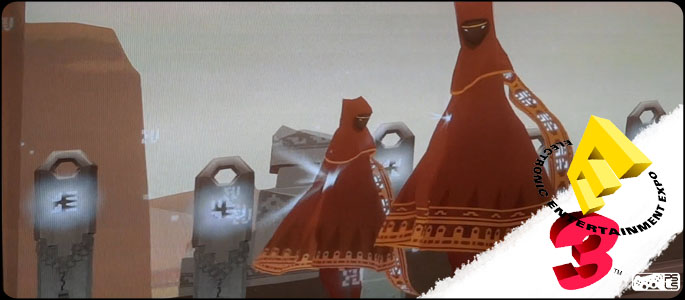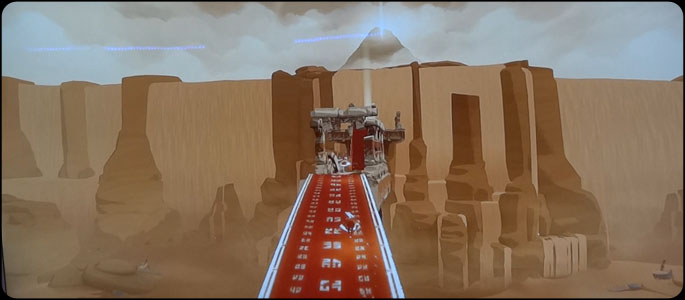
In most situations, referring to something as a “game” is fine. It’s what we do, after all, we work in the video games industry. In the case of Journey however, I think that noun is too limiting. I think calling it an experience, or even an epic doesn’t capture what Journey is. The best I can do — which is still a disservice — is to describe it as a type of emotional, artistic, expressive reality that everyone should experience. When the debate of can games be an art form arises, Journey answers the question quite resoundingly: Yes they can be.
Long before I was familiar with the work of Jenova Chen and ultimately thatgamecompany I remember discovering a game for the PC that changed my entire perception of gaming: Cloud. Developed by Jenova Chen and team, Cloud put itself on a short list of games that emotionally brought me to tears, it caused me to make a connection to it’s world and it’s characters in a way that I hadn’t before. I mention Cloud because, Journey (in the relatively short time I spent with it) reminded of a similar place I had been before, but yet in a completely different way. And all those feelings I had almost 10 years ago playing Cloud, all came rushing back when I played Journey.
When I started Journey, there was no tutorial, no explanation of the events I would see around me, nothing to tell me what I was supposed to—and it was perfect. I found myself in a simple, yet gorgeous, world, surrounded by a bright sky and sand, with a mountainous structure in the distance. The colors that existed around me, and the sheer level of detail to give the landscape this elegant look was breathtaking. As with a good film or television show, when you’re unsure of what is happening, what to expect, you can listen to the sounds, the music, to ascertain what is coming next. Journey does this in a fantastic way. The sounds, the symphonic cello music, are subtle, well orchestrated and help you to understand what is you’re supposed to do. At the heart of Journey is exploration. Exploration about the world around you, but equally as important, exploration about yourself and those you encounter as you understand what it is you need to do. Pictures don’t give an accurate idea of the scale of the game. The main character you control, is small, compared to the surroundings you’re in. The scale works because it immediately gave me the feeling that I was small piece in something larger that I was yet to experience—refreshing and intriguing at the same time.

As I progressed towards the mountain-like structure off in the distance, the “journey” aspect of the game became more real to me. When you drive to work or school, catch the train, ride your bike, or however you get there, the focus is on getting there. As I moved around Journey it reminded me to take my time, to take an everything that is around me—this is not a race to the finish but a walk through the park with the goal of finding something…understanding something. The sand you traverse feels real, you slide down dunes, and move at the rate as you would in a long trip, not sure what lies ahead. Controls were very simple, yet drove this point home: SixAxis tilt-sensing to look around, a button to sing, and one to jump. All the while I was playing alone, I couldn’t help asking myself: What is this place? Who am I? Even with the feeling of isolation, and loneliness (I had not met other players yet) something occurred to me: my cloak. It was hard to make out, and I can’t be entirely sure, but my cloak had symbols or markings on it that looked unique to me; something that, made me special and me an individual. A small touch that when I did meet another player, even though we looked the same, each of us had a different symbol—and that gave us something in common to build on even though we were strangers. This might sound trivial, but it added to that sense of questioning yet again, I was asking myself: Why I am here?
Traversing this world, I encountered a piece of fabric of some kind that, on a banner near a stone that allowed me to fly for a brief period. Even though the flight was short, the feeling of defying gravity for a brief time was done perfectly and added to the sense of wonder to figure out when and how this would come in to play. As I moved past that, I came across a glowing statue of sorts, that was mesmerizing, and then my time with Journey came to an end. I’ve omitted some things purposely from the story, but I don’t want to give away that moment, the one I mentioned earlier that tugged at my heartstrings in a way I haven’t felt from a game in awhile. When it happens to you, you will thank me that I didn’t spoil it for you.
Looking back, maybe I should have played more, should have tried to “finish” more of the demo, but, that wasn’t the point I think. Jenova Chen and the rest of the brilliant persons involved have created a fluid, moving, vibrant world that is alive, that you want to be a part of. Journey is redefining what it means to experience entertainment on the PS3. For the first time, I can imagine a family of all ages sitting around the TV with everyone experiencing this world while the resident “gamer” guides them through it. That family I mentioned earlier can work together, talk, share thoughts and ideas of how to proceed, and without a doubt be emotionally moved together as well. Journey will be the game that means different things to different people, and results in passionate discussion about what each element in the title represents.
Journey is the single most impressive title I have ever played on the PSN. When discussions about games as an art and entertainment form arise, Journey will be at the center of it. More than anything, I think, Journey forces you to ask those questions we talked about earlier in your own life: Why I am here? Who am I? Many of the sights and sounds of E3 have already faded for me, but it feels like I just played Journey minutes ago…








